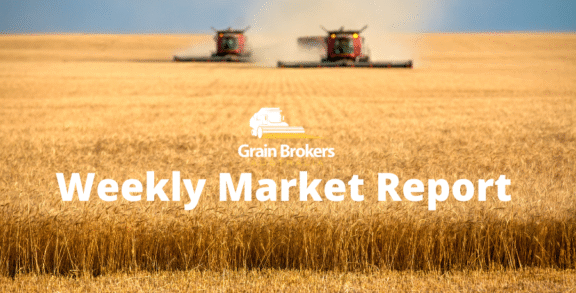
Market pressure, particularly from Russia, continues to build for Kazakhstan’s grain farmers, leading to a significant decrease in the number of countries importing grain from Central Asia’s biggest producer over the past 20 years. However, after considerable government lobbying, grain exports to China are moving in the opposite direction, slowly rising in recent years and building a sound platform for ongoing growth.
The government in Astana sees China as a critical trade partner for future prosperity and is very keen to build on relations with its eastern neighbour. According to Aidarbek Saparov, the Minister of Agriculture of the Republic of Kazakhstan the Chinese market is of great interest for the export of agricultural produce, and Kazakhstan is ready to supply upwards of two million metric tonne of grain to China annually.
The minister noted that cooperation in the field of agriculture is an essential component of Kazakh-Chinese relations, which is supported by positive dynamics in the trade of agricultural produce between the countries. Export of farm goods to China almost doubled in 2023, reaching US$1.01 billion in value. In addition to the existing grain agreement, the two nations are expected to sign bilateral agreements on the export of additional agricultural products, such as chilled meat, poultry products, processing byproducts, beet pulp and potatoes, sometime this year.
On the production front, hot and dry weather during the 2023 summer compromised the development, growth and yield of Kazakhstan’s winter and spring cereals. This was followed by frequent and abundant precipitation throughout August and September, severely hampering harvest in the northern and eastern regions, further reducing yield and dramatically reducing grain quality.
According to official government data, the harvest of winter and spring wheat in Kazakhstan in 2023 collectively amounted to 12.1mmt after cleaning, down more than 26 per cent from 16.4mmt in 2022. The total area planted to wheat was 13.8 million hectares, up 6.8 per cent compared to the prior season, and the harvested area of 13.1 million hectares was up 2.5 per cent season-on-season. The average clean yield was 0.92 metric tonne per hectare was almost 28 per cent lower than the 2022 harvest result of 1.27mt/ha.
On the quality front, only 21 per cent of the wheat reaped last year met food-grade criteria, according to industry participants. Feed grades accounted for 29 per cent, but half of the harvested wheat was of such poor quality that it could not be classified. Of the classified wheat, the average protein was 14.5 per cent or higher and gluten content was 31.5 per cent or higher. However, the mean test weight was well below normal at 74.3 kilograms per hectolitre (kg/hL), and the average falling numbers result was less than 160 seconds.
Last year’s barley harvest totalled 2.6mmt, down 21 per cent from 3.3mmt in the 2022/23 season. The planted area of 2.6 million hectares was 18 per cent more than the prior crop year, and the harvested area of 2.4 million hectares was 11 per cent higher. The average clean yield was 1.08mt/ha, 29 per cent lower than the previous season.
Barley quality was also severely impacted by the weather. The average protein content was extremely high at 14.3 per cent, but the mean test weight of 66.1kg/hL was much lower than the long-term average. Unsurprisingly, the wet harvest conditions led to a higher-than-normal presence of mycotoxins and aflatoxins in both wheat and barley.
Kazakhstan resides in a very unpredictable agricultural zone, which is borne out in the country’s yield statistics. It ranks around eighth or ninth in terms of grain trade. Among grain producers, it ranks around thirteenth or fourteenth by volume in a typical production year. However, in terms of average cereal yield, Kazakhstan ranks 103rd to 109th out of a field of 130 countries. The main contributing factors are the arid environment and the country’s reliance, due to its latitude, on spring-sown varieties, which have a much shorter growing season, hence lower yield potential.
The large wheat harvest in 2022 and relatively modest exports of 10.5mmt in the 2022/23 marketing year (September to August) meant Kazakhstan had the luxury of a relatively high 2023/24 carry-in of approximately 3.3mmt of very high-quality wheat to keep the domestic flour millers and exporters supplied. This will be supplemented with around 2mmt of “official” imports, predominantly from Russia, giving a total 2023/24 wheat supply of around 17.4mmt. While this is down from 21mmt in 2022/23, it is still high by recent standards and is expected to facilitate an export program for wheat, flour and byproducts approximating a wheat equivalent total of 10mmt.
In the first quarter of the marketing year, exports of wheat and wheat equivalent flour products totalled 2.1mmt. This is down 20 per cent compared to the same period in 2022/23 with Uzbekistan, Afghanistan, and Tajikistan the top three destinations. Wheat consignments to Uzbekistan were reported at 926,000mt, down 18 per cent on the prior corresponding period. Afghanistan was the second largest importer at 475,000mt, a decrease of 38 percent and Tajikistan imported 304,000 MT, almost 22 per cent lower.
While it is still a work in progress and is starting from a low base, Kazakhstan has significantly increased wheat and barley exports to China in the 2023/24 marketing year. In the first four months of the current export campaign, 154,000 metric tonne of wheat was sent to China, predominantly by rail, compared to just under 23,000mt in the same period in the 2022/23 marketing year. Interestingly, feed grade demand has dominated Chinese enquiry, which is very helpful when there are significant stocks of lower quality feed wheat from the 2023 harvest.
In the same four-month period to the end of December 2023, barley exports totalled 429,000mt, 3.25 times higher than the 132,000mt shipped in the same stretch 12 months earlier. November was the peak month with 163,000mt. However, logistics challenges are reported to have adversely impacted December volumes for both barley and wheat.
While Kazakhstan lies on the Caspian Sea, it is considered the world’s largest landlocked country, completely cut off from global sea trade. It has traditionally gained access to global markets through Russian territory and its Black Sea ports. However, with the dramatic rise in Russian production and export volumes over the past two years, almost all of its logistics and port capacity has been required to ship its own agricultural produce.
Grain from Kazakhstan is now only shipped via Russia when residual export capacity is available, which has been rare in the past couple of years, effectively locking the country out of the world market. While this has increased the country’s reliance on traditional Central Asian customers and resuming exports to Caspian Sea customer Iran, it places immense importance on China as a market of the future for Kazakhstan’s struggling farmers.
Call your local Grain Brokers Australia representative on 1300 946 544 to discuss your grain marketing needs.





